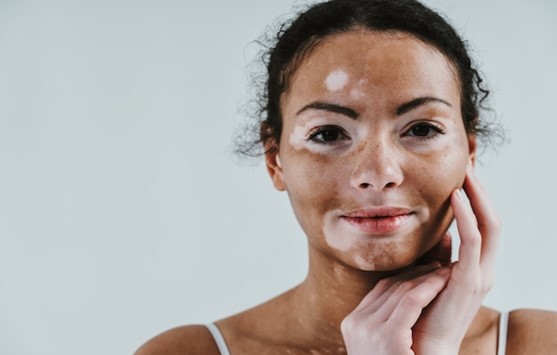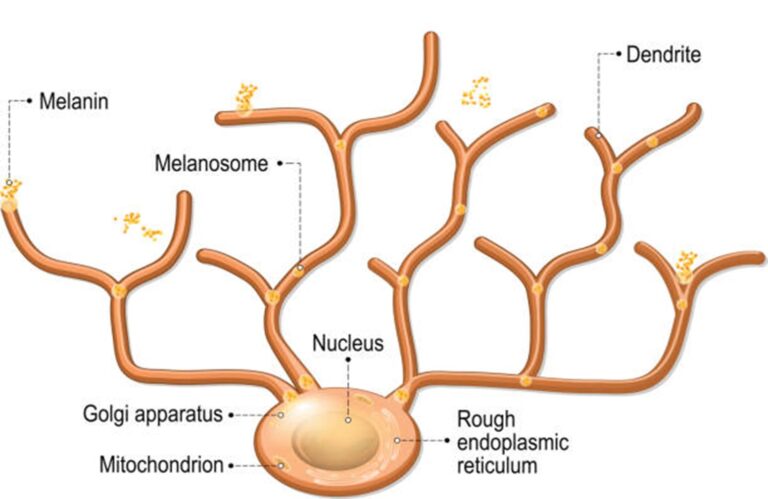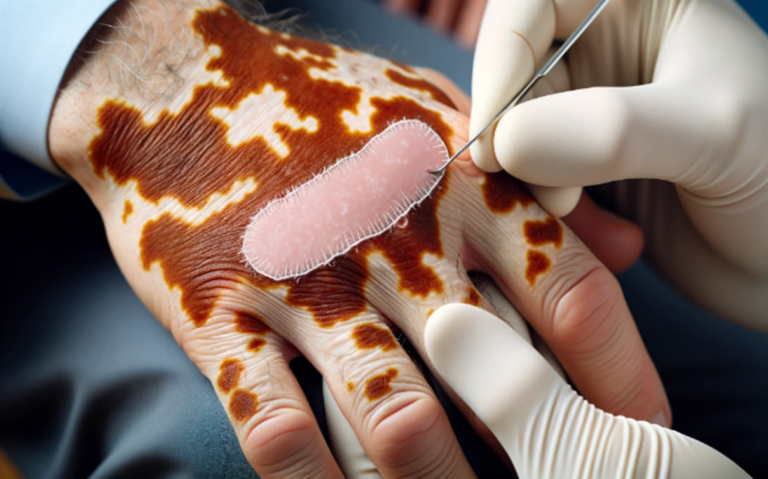Vitiligo, a skin condition that causes patchy loss of skin pigment, affects millions of people worldwide. If you or your loved ones are battling with vitiligo, you understand the emotional and physical toll it can take.
The search for the best vitiligo treatment in Hyderabad can sometimes feel daunting, but there’s good news. Melanocytes transfer for vitiligo treatment in Hyderabad is emerging as a promising solution. It might be the answer you have been seeking.
At Redefine Plastic Surgery Clinic in Hyderabad, Dr. Harikiran Chekuri, an esteemed plastic surgeon, has been at the forefront of this innovative treatment. Guided by Dr Harikiran’s expertise and experience of over 20 years in plastic surgery, many have found hope and reclaimed their natural skin tone.
In this blog, we will explore how melanocytes transfer can be the game-changer in your journey toward healthy, even-toned skin.

Dive right in, and let’s explore melanocytes.
Understanding Melanocytes

Melanocytes are specialized skin cells that produce melanin. It is a pigment responsible for skin, hair, and eye colour. They regulate skin tone by determining the amount and type of melanin produced.
When melanocytes function properly, they provide an even skin tone. If they produce excessive or less melanin, it can lead to pigmentation issues such as vitiligo, melasma, hyperpigmentation, and hypopigmentation.
Vitiligo is a common skin pigmentation disorder caused by the destruction of melanocytes. It affects approximately 0.5 to 2% of the global population. In India, the prevalence of vitiligo is estimated to be around 0.5 to 8.8%. This is slightly higher than the global average. Vitiligo can affect individuals of any age, gender, or ethnic background. However, it is more noticeable in people with darker skin tones.
Fast, efficient, and effective vitiligo treatment is just a click away! Explore your options with our seasoned vitiligo doctor in Hyderabad. Let’s get started!
Now, let’s know,
What Exactly is Melanocyte Transfer?

Melanocyte transfer is a medical treatment that helps restore skin pigment. The procedure is especially beneficial for individuals with vitiligo.
During this treatment, doctors extract melanocytes from a healthy skin patch. These are then multiplied in a laboratory. Then, the doctor transplants them into the affected areas. The goal is to restore pigment and improve the skin’s appearance. It is a potential solution for those suffering from uneven skin pigmentation conditions like vitiligo.
With advancements in medical science and increased awareness, more people in India are seeking treatments like melanocytes transfer to manage and potentially reverse the effects of vitiligo.
Discover Vitiligo Treatment Options with Dr. Harikiran Chekuri
Melanocyte transfer is a medical treatment that helps restore skin pigment. The procedure is especially beneficial for individuals with vitiligo.
During this treatment, doctors extract melanocytes from a healthy skin patch. These are then multiplied in a laboratory. Then, the doctor transplants them into the affected areas. The goal is to restore pigment and improve the skin’s appearance. It is a potential solution for those suffering from uneven skin pigmentation conditions like vitiligo.
With advancements in medical science and increased awareness, more people in India are seeking treatments like melanocytes transfer to manage and potentially reverse the effects of vitiligo.
There are several methods for melanocyte transfer. But which one is right for you? Let’s see.
Melanocyte Transfer Methods

Melanocytes transfer plays a pivotal role in managing skin conditions like vitiligo. Here’s a breakdown of the primary methods:
In this technique, the surgeon takes a small piece of healthy skin, often from a less noticeable area like the thigh. They then transplant it to the affected area. It allows the melanocytes to spread and repigment the skin.
- Cultured Melanocytes:
This method involves harvesting melanocytes from a small skin sample. In a lab, a technician cultures and multiplies these cells. Once ready, the surgeon injects these cells into the depigmented areas. It helps restore natural skin colour.
- Mini Punch Grafting:
This method involves taking tiny skin grafts from a pigmented area and transplanting them to the affected areas.
- Thin Skin Grafting:
In this method, the surgeon takes a thin layer of pigmented skin. Then, they graft it onto the depigmented area.
- Blister Grafting:
Blisters are raised on the pigmented skin using suction. Then, the surgeon transfers the top layer of these blisters to the affected area.
- Melanocyte-Keratinocyte Suspension:
During this procedure, the surgeon extracts and mixes the melanocytes with keratinocytes. Then, they apply them to the prepared depigmented skin.
- Hair Follicle Transplant:
Hair follicles contain melanocytes. In this method, the surgeon transplants the hair follicles from pigmented areas to the affected regions.
All these methods aim to restore skin colour and improve appearance. It is important to consult one of the best doctors for vitiligo treatment in Hyderabad, such as Dr Harikiran Chekuri, to determine the most suitable method for your case.
Eager to know more? Let’s walk through the Step-by-Step Procedure of Melanocyte Transfer
Step-by-Step Procedure of Melanocyte Transfer

- Preparation:
First, the surgeon will clean the affected area of the skin. This ensures that the site is free from any contaminants.
- Tissue Collection:
The surgeon takes a small skin sample from a pigmented area of the patient’s body. This sample usually comes from the thigh or buttock.
- Cell Isolation:
In a lab, the technician separates the melanocytes (pigment-producing cells) from the collected tissue.
- Cell Suspension:
The surgeon suspends these isolated melanocytes in a solution. This makes it easier to apply them to the affected areas.
- Application to the Affected Area:
Next, the surgeon creates tiny abrasions in the depigmented skin using a specialized tool. This helps the new melanocytes adhere better. Then, the surgeon applies the melanocyte suspension over these abraded areas.
- Dressing:
To aid healing and protect the area, the surgeon applies a sterile dressing. This stays on for about a week.
- Post-Procedure Care:
Patients should follow their surgeon’s instructions closely. This ensures the transferred melanocytes settle well and start producing pigment.
By undergoing melanocytes transfer, patients can witness a significant improvement in their skin’s appearance. However, individual results may vary. It is crucial to consult a skilled plastic surgeon to understand the potential outcomes and if this treatment is right for you.
Are you considering melanocyte transplant surgery? Then, understanding the cost is essential for making informed decisions. Ask the specialist
How much is the Melanocyte Transplantation Cost in Hyderabad?
The approximate cost of melanocyte transplantation in Hyderabad ranges from INR 50,000 to INR 2,00,000 or more. However, the melanocyte transplantation cost, like many medical procedures, can vary based on several factors, such as:
- extent of the treatment area
- complexity of the procedure
- surgeon’s experience
- clinic’s reputation
- any additional treatments or services required
It is advisable to consult directly with a reputable plastic surgeon in Hyderabad to get the most accurate and up-to-date pricing information. They can provide a personalized quote based on your needs during a consultation. Always prioritize quality and the surgeon’s experience to ensure the best outcomes. Remember, your health and safety come first.
Now, let’s discuss something everyone is curious about – the success rate.
How much is the Melanocyte Transplantation Cost in Hyderabad?
The approximate cost of melanocyte transplantation in Hyderabad ranges from INR 50,000 to INR 2,00,000 or more. However, the melanocyte transplantation cost, like many medical procedures, can vary based on several factors, such as:
- extent of the treatment area
- complexity of the procedure
- surgeon’s experience
- clinic’s reputation
- any additional treatments or services required
It is advisable to consult directly with a reputable plastic surgeon in Hyderabad to get the most accurate and up-to-date pricing information. They can provide a personalized quote based on your needs during a consultation. Always prioritize quality and the surgeon’s experience to ensure the best outcomes. Remember, your health and safety come first.
Now, let’s discuss something everyone is curious about – the success rate.
Success Rate of Melanocyte Transplant
Several studies have shown success rates of melanocyte transplant around 60% to 95%. It is crucial to understand that “success” might not always imply complete repigmentation. Instead, it often refers to substantial improvement that satisfies both the patient and the doctor.
The success rate of melanocyte transplant surgery for vitiligo can vary based on several factors:
- Location of Vitiligo:
The success rate tends to be higher for lesions on the face compared to other areas, such as the hands, feet, and joints.
- Stability of Vitiligo:
Vitiligo must be stable before a transplant. This means no new lesions or expansion of current ones for at least a year. Unstable vitiligo risks the new melanocytes being attacked by the immune system.
- Type of Vitiligo:
Localized vitiligo (like focal or segmental) tends to respond better to treatment than generalized or universal vitiligo.
- Duration of the Condition:
The duration of vitiligo can sometimes influence the outcomes. Some studies suggest that newer lesions respond better than older lesions.
- Procedure Technique:
The surgeon’s experience and the specific technique can also influence the outcomes. Proper patient selection, preparation of the recipient site, and aftercare can play significant roles in the procedure’s success.
- Post-procedure Care:
Proper care after the surgery, including protection from the sun, can significantly impact the results.
Melanocyte transplant surgery has shown promising results in managing vitiligo symptoms. However, the success rate can vary depending on the factors mentioned above. It is crucial to discuss the procedure, expectations, and potential risks with a dermatologist or plastic surgeon who specializes in the technique.
Living with vitiligo? It’s time to embrace your healing journey. Let’s talk solutions. Please schedule your appointment with our vitiligo specialist in Hyderabad today!
Now, let’s explore the,
Advantages of Melanocytes Transfer for Vitiligo Patients
- Targeted Treatment:
This technique directly targets the affected areas by transplanting active melanocytes.
- Quick Recovery:
Patients usually experience faster healing and shorter recovery times than any other surgical treatment for vitiligo.
- Natural Results:
Since the transferred cells come from the patient’s body, the skin tone often looks natural and blends well.
- Long-lasting Effects:
Once the melanocytes start producing pigment, the results can last long.
- Minimal Scarring:
The procedure results in minimal or no scarring. This helps in maintaining the skin’s aesthetic appeal.
- Safe for Various Skin Types:
Melanocyte transfer is suitable for different skin types and colours. This makes it accessible to a wide range of individuals.
Let’s discuss what you can expect and the steps you need to take to ensure optimal results.
Aftercare and Recovery for Melanocyte Transfer
Melanocyte transfer is an advanced medical procedure. Proper aftercare is essential to ensure successful results. Here’s what you need to know:
- Immediate Care:
After the procedure, it is common to experience some redness or swelling. Keep the treated area clean and avoid touching it.
- Moisturization:
Apply a gentle moisturizer as directed by your doctor. This keeps the skin hydrated and supports healing.
- Sun Protection:
Protect the treated area from direct sunlight. Wear a broad-spectrum sunscreen and cover the area with clothing when outside.
- Avoid Irritants:
Stay away from harsh soaps, chemicals, or skincare products. They can irritate the skin and hinder recovery.
- Follow-Up Appointments:
Attend follow-up appointments. This helps your surgeon to monitor healing and address any concerns.
- Report Concerns:
If you notice any unusual symptoms, like excessive pain or unexpected skin changes, contact your doctor immediately.
Remember, everyone’s recovery journey is unique. Trust your doctor’s guidance and give your skin the care it deserves.
Conclusion
Melanocytes transfer is a promising treatment for individuals with vitiligo. It offers a chance to restore pigment to areas of lost coloration. As with any medical procedure, understanding the process, risks, and post-care is crucial.
Always consult a qualified professional like Dr. Harikiran Chekuri, a renowned specialist in plastic surgery in Hyderabad, to determine if this procedure aligns with your needs and health conditions. Protecting and taking care of the treated area can help ensure long-lasting results.
Together with the guidance of medical professionals, melanocyte transfer can provide a pathway to enhanced skin health and confidence.
FAQs:
- Is the melanocytes transfer procedure painful?
Most patients experience minimal pain. Doctors usually apply local anesthesia to numb the area during the procedure.
- How long does the procedure take?
The duration varies based on the extent of the treatment area. However, it typically lasts a few hours.
- Are there any risks or side effects?
Some potential side effects include infection, scarring, or uneven pigmentation. Always discuss potential risks with your doctor.
- How soon will I see the melanocytes transfer results?
Patients usually notice pigment returning within a few weeks to months. However, multiple sessions might be necessary for optimal results.
- Are the results permanent?
The results can be long-lasting. However, it is essential to protect the treated area from sun exposure to maintain the pigment.
- Can I undergo melanocyte transfer if I have other medical conditions?
Consult with your doctor. Some medical conditions or medications might affect the outcome or eligibility for the procedure.
- How should I prepare for the procedure?
Your doctor will provide specific instructions. Generally, you should avoid sun exposure and certain medications before the procedure.










